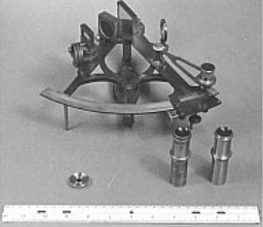
Edmund Blunt and his sons, George and William Blunt, opened their own shop in New York in 1824, where they began offering nautical books, charts and instruments under the company name E. & G. W. Blunt. After building a circular dividing engine in the mid-1850’s, the Blunts began advertising “Sextants, Quadrants, &c. of American manufacture.” The firm then became Blunt and Nichols in 1866.16 Sextants like this one were used in early modern Europe, particularly Hadley’s sextant. From the 1730’s onward, Hadley’s sextant “enabled latitude to be determined accurately and expeditiously.”2 It gets its name from the curved scale or arc on the end, which is 60º (a sixth of a circle), thus allowing it to measure angles of 60º.4 However, the doubly reflecting mirror in this sextant allows it to measure angles of 120º.4 The sextant could be used during the day or night. During the day, it could be used to measure the angle of the sun to the horizon. At night, it could be used to measure the angles of celestial objects.2 The complicated nature of this artifact overshadows its utility, and was fairly easy to use unless the ship was rocking back and forth, or inclement weather prevented observations from being made.4 Stands for the sextants could be provided for both land and sea for more stability.2 The importance of the sextant cannot be understated. It was the main instrument of choice for seafarers looking to use heavenly objects to calculate latitude. It was also used with the other celestial navigational equipment in the exhibition when calculating lunar distances for longitude to check the going rates of the chronometers.2